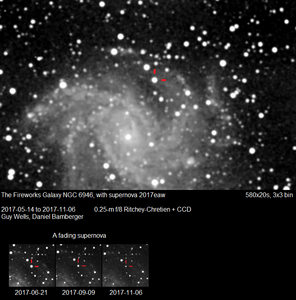
Messier 61 is an intermediate barred spiral galaxy in the Virgo Cluster of galaxies. It was first discovered by Barnaba Oriani on May 5, 1779, six days before Charles Messier discovered the same galaxy. Messier had observed it on the same night as Oriani but had mistaken it for a comet. Its distance has been estimated to be 45.61 million light years from the Milky Way Galaxy. It is a member of the M61 Group of galaxies, which is a member of the Virgo II Groups, a series of galaxies and galaxy clusters strung out from the southern edge of the Virgo Supercluster.

NGC 300 (also known as Caldwell 70) is a spiral galaxy in the constellation Sculptor. It is one of the closest galaxies to the Local Group, and probably lies between the latter and the Sculptor Group. It is the brightest of the five main spirals in the direction of the Sculptor Group. It is inclined at an angle of 42° when viewed from Earth and shares many characteristics of the Triangulum Galaxy. It is 94,000 light-years in diameter, somewhat smaller than the Milky Way, and has an estimated mass of (2.9 ± 0.2) × 1010M☉.

The Whirlpool Galaxy, also known as Messier 51a (M51a) or NGC 5194, is an interacting grand-design spiral galaxy with a Seyfert 2 active galactic nucleus. It lies in the constellation Canes Venatici, and was the first galaxy to be classified as a spiral galaxy. It is 32 million light-years away and 109,000 ly (33,280 pc) in diameter.
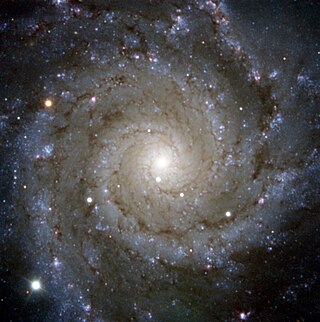
Messier 74 is a large spiral galaxy in the equatorial constellation Pisces. It is about 32 million light-years away from Earth. The galaxy contains two clearly defined spiral arms and is therefore used as an archetypal example of a grand design spiral galaxy. The galaxy's low surface brightness makes it the most difficult Messier object for amateur astronomers to observe. Its relatively large angular size and the galaxy's face-on orientation make it an ideal object for professional astronomers who want to study spiral arm structure and spiral density waves. It is estimated that M74 hosts about 100 billion stars.

Messier 95, also known as M95 or NGC 3351, is a barred spiral galaxy about 33 million light-years away in the zodiac constellation Leo. It was discovered by Pierre Méchain in 1781, and catalogued by compatriot Charles Messier four days later. In 2012 its most recent supernova was discovered.

NGC 3982, also known as UGC 6918, is an intermediate spiral galaxy approximately 68 million light-years away in the constellation Ursa Major. It was discovered by William Herschel on April 14, 1789, and misclassified as a planetary nebula. NGC 3982 is a part of the M109 Group.
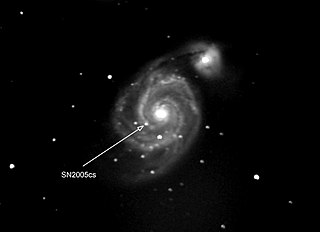
SN 2005cs was a supernova in the spiral galaxy M51, known as the Whirlpool Galaxy. It was a type II-P core-collapse supernova, discovered June 28, 2005 by Wolfgang Kloehr, a German amateur astronomer. The event was positioned at an offset of 15″ west and 78″ south of the galactic nucleus of M51. Based on the data, the explosion was inferred to occur 2.8 days before discovery. It was considered under-luminous for a supernova of its type, releasing an estimated 3×1050 erg in energy.

NGC 7793 is a flocculent spiral galaxy in the southern constellation of Sculptor. It was discovered in 1826 by Scottish astronomer James Dunlop. The galaxy is located at a distance of 12.2 million light years and is receding with a heliocentric radial velocity of 227 km/s. NGC 7793 is one of the five brightest galaxies within the Sculptor Group.

NGC 1309 is a spiral galaxy located approximately 120 million light-years away, appearing in the constellation Eridanus. It is about 75,000 light-years across, and is about 3/4s the width of the Milky Way. Its shape is classified as SA(s)bc, meaning that it has moderately wound spiral arms and no ring. Bright blue areas of star formation can be seen in the spiral arms, while the yellowish central nucleus contains older-population stars. NGC 1309 is one of over 200 members of the Eridanus Group of galaxies.

NGC 4639 is a barred spiral galaxy located in the equatorial constellation of Virgo. It was discovered by German-born astronomer William Herschel on April 12, 1784. John L. E. Dreyer described it as "pretty bright, small, extended, mottled but not resolved, 12th magnitude star 1 arcmin to southeast". This is a relatively nearby galaxy, lying approximately 72 million light-years away from the Milky Way. It is a companion to NGC 4654, and the two appear to have interacted roughly 500 million years ago. NGC 4639 is a member of the Virgo Cluster.

SN 2003gd was a Type II-P supernova explosion in the spiral galaxy Messier 74, located in the constellation Pisces. SN 2003gd was discovered on 12 June 2003 by Robert Evans, using a 0.31m reflector, and its discovery was confirmed on 13 June 2003 by R. H. McNaught using the 1.0m telescope at the Siding Spring Observatory.
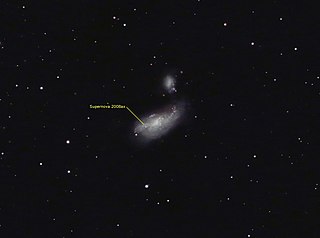
SN 2008ax was a helium-rich type Ib core-collapse supernova in the interacting galaxy NGC 4490. It was independently discovered on 3 March 2008 by LOSS and 4 March by Koichi Itagaki. The site had been monitored six hours before discovery, thus constraining the time of the explosion breakout. It was the third-brightest supernova of 2008. The brightness in the B-band peaked about 20 days after the explosion. X-ray emissions were detected from the event, which are most likely the result of shock heating from the supernova ejecta and circumstellar material.

NGC 7424 is a barred spiral galaxy located 37.5 million light-years away in the southern constellation Grus. Its size makes it similar to our own galaxy, the Milky Way. It is called a "grand design" galaxy because of its well defined spiral arms. Two supernovae and two ultraluminous X-ray sources have been discovered in NGC 7424.
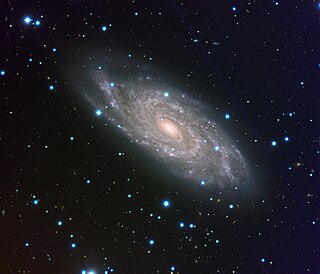
NGC 6118 is a grand design spiral galaxy located 83 million light-years away in the constellation Serpens. It measures roughly 110,000 light-years across; about the same as our own galaxy, the Milky Way. Its shape is classified as "SA(s)cd," meaning that it is unbarred and has several rather loosely wound spiral arms. The large numbers of bright bluish knots are active star-forming regions where some very luminous and young stars can be perceived.

NGC 4666 is a spiral galaxy in the equatorial constellation of Virgo, located at a distance of approximately 55 megalight-years from the Milky Way. It was discovered by the German-born astronomer William Herschel on February 22, 1784. It is a member of the Virgo II Groups, a series of galaxies and galaxy clusters strung out from the southern edge of the Virgo Supercluster. John L. E. Dreyer described it as "bright, very large, much extended 45°±, pretty suddenly brighter middle". It is a member of an interacting system with NGC 4668 and a dwarf galaxy, and belongs to a small group that also includes NGC 4632.
SN 1917A is a supernova event in the Fireworks Galaxy, positioned 37″ west and 105″ south of the galactic core. Discovered by American optician George Willis Ritchey on 19 July 1917, it reached a peak visual magnitude of 13.6. Based on a poor quality photographic spectrum taken at least a month after peak light by F. G. Pease and Ritchey, it was identified as a type II core-collapse supernova.

NGC 5806 is an intermediate spiral galaxy in the constellation Virgo. It was discovered on February 24, 1786, by the astronomer John Herschel. It is located about 70 million light-years away from the Milky Way. It is a member of the NGC 5846 Group.
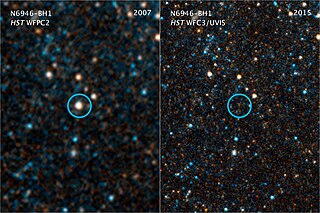
N6946-BH1 is a disappearing supergiant star formerly seen in the galaxy NGC 6946, on the northern border of the constellation of Cygnus. The star, either a red supergiant or a yellow hypergiant, was 25 times the mass of the Sun, and was 20 million light years distant from Earth. In March through to May 2009 its bolometric luminosity increased to at least a million solar luminosities, but by 2015 it had disappeared from optical view. In the mid and near infrared an object is still visible, however, it is fading away with a brightness proportional to t−4/3. The brightening was insufficient to be a supernova, and is called a failed supernova.
SN 2013ej is a Type II-P supernova in the nearby spiral galaxy Messier 74. It was discovered by the Lick Observatory Supernova Search on July 25, 2013, with the 0.76 m Katzman Automatic Imaging Telescope, with pre-discovery images having been taken the day before.

SN 2004et is a bright type IIP supernova that occurred in the spiral galaxy NGC 6946, about 22 million light years away from earth. The star that made the supernova was falsely identified to be a yellow supergiant but was then identified to be a type red supergiant of 13.8 solar masses. It was discovered alongside SN 2017eaw. SN 2004et showed some rebrightening about 1000 days after the initial supernova probably due to ejecta of circumstellar material or thermal echo. SN 2004et was one of the most luminous type IIP supernovae ever recorded and characterized.


